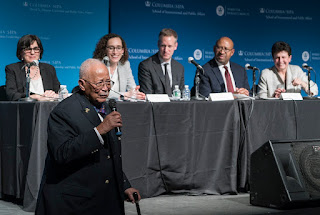More Than Just A Court
Earlier this week, I spoke at the David N. Dinkins Leadership and Public Policy Forum at Columbia University. It was a nice event, highlighted by a keynote address by former US Attorney General Eric Holder, who talked about the need to address the over-use of incarceration in this country.
When it was my turn to speak, I decided to tip my hat to the evening's host, former New York City Mayor Dinkins. If you follow the dominoes, you could argue that I owe my career to Dinkins -- his decision to invest in the Midtown Community Court helped set the wheels in motion that ultimately led to the creation of the Center for Court Innovation.
This is a version of what I said at the Dinkins forum (definitely not verbatim):
I got my start in criminal justice in 1993. Working for John Feinblatt, I played a small role in the planning of the Midtown Community Court. Midtown was (and is) a neighborhood-based court that seeks to focus on misdemeanor crime in and around Times Square, offering alternatives to fines and short jail sentences. It also seeks to treat individual defendants with dignity and respect, and to link them to the kinds of social services – drug treatment, counseling, job training – that might help them get their lives back on track.
In attempting to do all this, Midtown was tilting into a pretty strong head wind. Remember, the context was 1993. We were coming off a decade when they regularly made movies like Escape from New York, The Warriors, and Fort Apache the Bronx that offered a fairly bleak portrait of life in New York City. The crack epidemic was still very much in the forefront of people’s minds. This was an era of tough-on-crime legislation. Megan’s Law, Three-Strikes-and-You’re-Out, mandatory minimums…the net effect of all this was to toughen penalties for criminal behavior and tilt the scales of justice in the direction of prosecutors.
Given this backdrop, it took a measure of political courage to greenlight a project like the Midtown Community Court which explicitly sought to provide help to criminal defendants and was vehemently opposed by the Manhattan District Attorney’s Office. The Mayor who made Midtown happen was David Dinkins.
In an editorial entitled “More than just a court” endorsing the project, the New York Times had this to say about Midtown:
The court that Mayor David Dinkins announced this week could improve justice and the quality of life where minor crime has become routine. The Midtown Community Court will hear misdemeanor cases. Rather than impose fines or short jail terms as is now common, the new court would sentence many such offenders to useful tasks like cleaning graffiti, helping at soup kitchens or sorting trash at recycling centers. At the same time it would link them to social services available at the courthouse. It is a sound investment that could greatly enhance justice in the perception of both criminals and victims.
When Midtown was first launched in 1993 it was viewed as a radical, out-of-the-box idea. If you fast forward to today, you will see that the rest of the criminal justice system in New York City has come to look a lot like the Midtown Community Court.
New York City is much safer than it used to be. Less well documented is the reality that the use of jail has also declined significantly. Like crime, incarceration is down, and not just by a little. The use of jail in New York peaked at more than 20,000 in the 1990s. Today, there are less than 8,500 people behind bars. (As I have written elsewhere, this success is not down to any individual politician or piece of legislation, but rather the product of incremental changes that took place over the course of a generation.)
New York City has the lowest incarceration rate of all large American cities. And it accomplished this during a period when incarceration rates were rising across the country. Remarkably, it is now possible to imagine closing Rikers Island. Indeed, this is the official policy of the City of New York thanks to Mayor Bill De Blasio. To say that this would have been inconceivable in 1993 is an understatement.
So that’s the good news. The bad news is that even though NYC is an international model of criminal justice reform, we still have glaring problems in our criminal justice system.
If you take a trip to criminal court, the racial disparities in our system will smack you in the face. And if you visit Rikers Island, you will see that the system is not really designed to recognize the fundamental humanity of those within it (be they detainees or correction officers). Rather, it feels like the criminal justice system is an accelerant of human misery – that it takes people struggling with addiction and joblessness and mental health issues and other individual problems and makes them worse.
There are many challenges that we need to confront before we can be said to have a justice system that lives up to its highest ideals in terms of fairness and effectiveness. But the biggest challenge for me is time.
I don’t think that the kind of transformation that we need to see in the justice system is going to happen overnight. It is going to take time to win the hearts and minds of those who operate the justice system. Unfortunately, there are dozens of other worthy issues competing for our (limited) attention spans. If I could ask for just one thing for those of us who are in the business of criminal justice reform, it would be the gift of patience.


